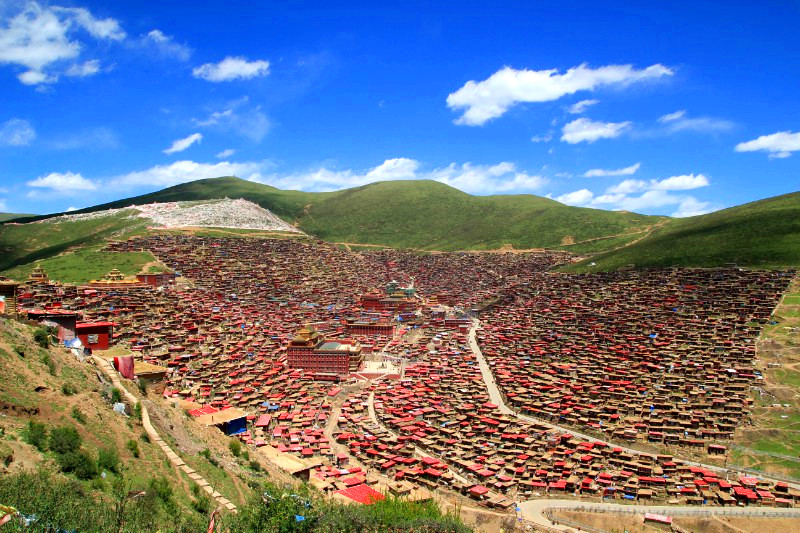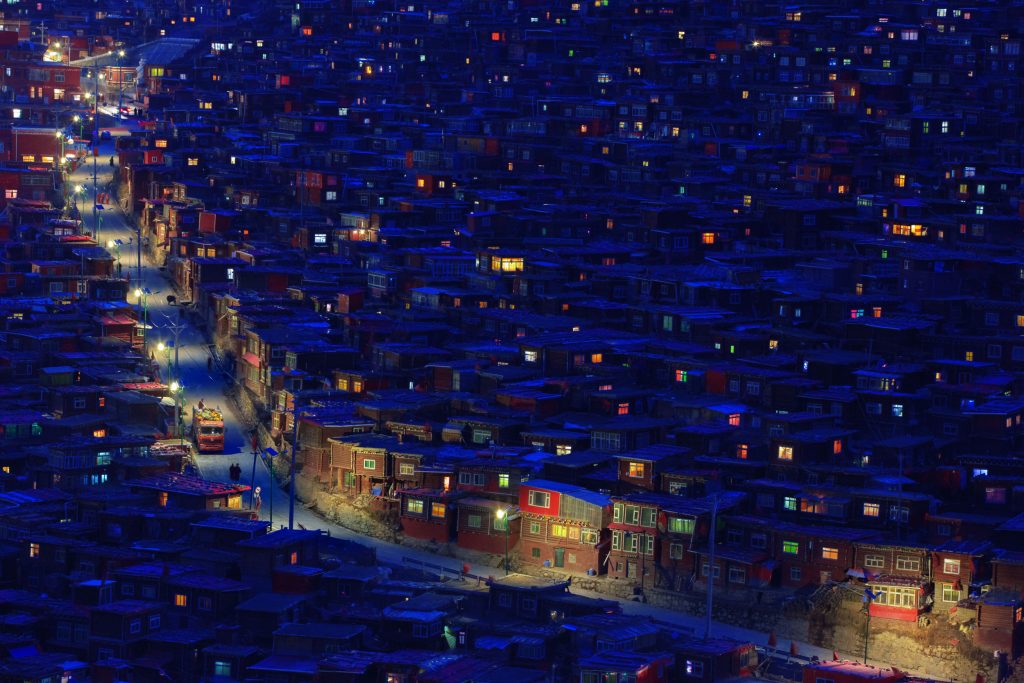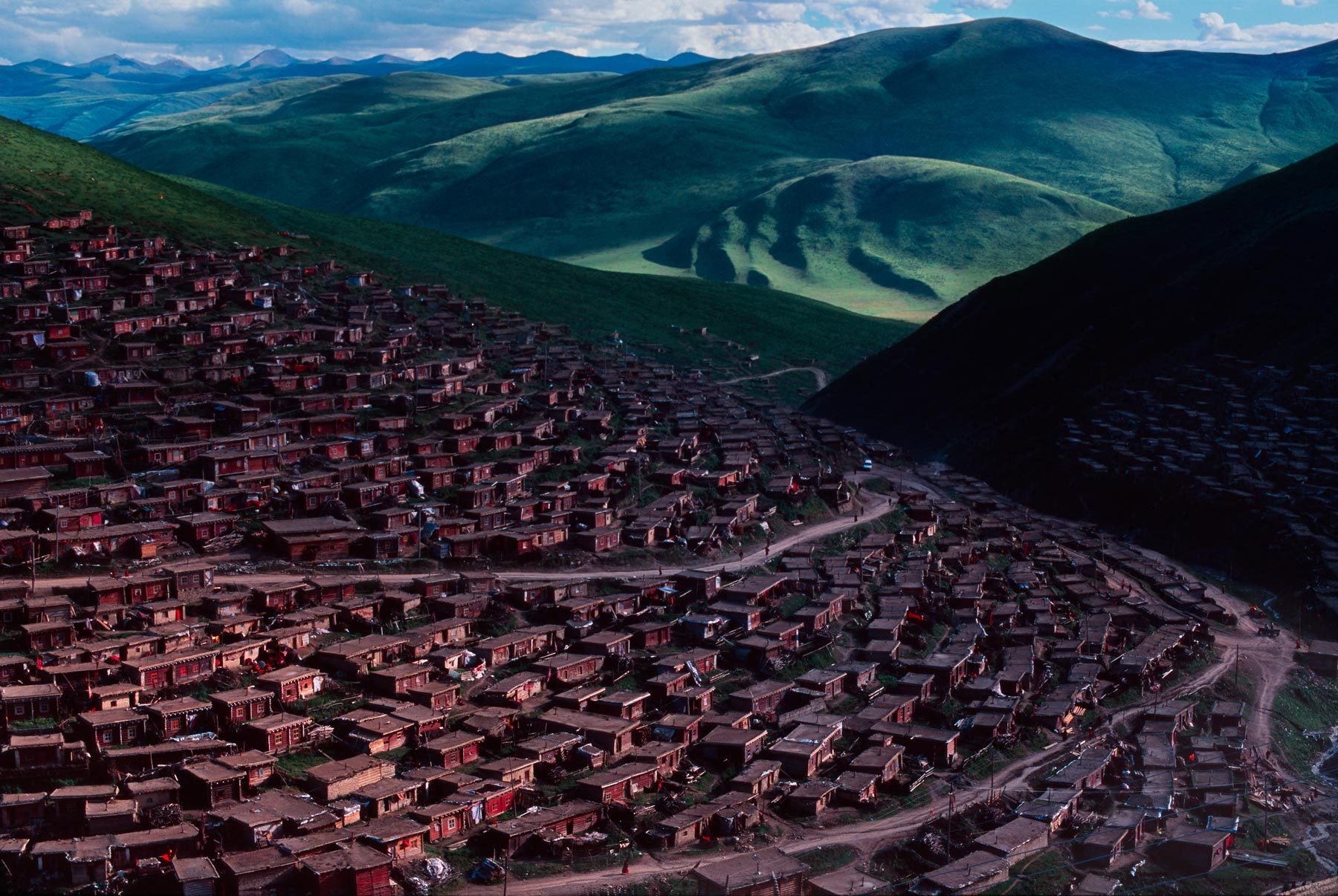Tibet’s Larung Gar Demolition In The Name of Resurrection ; Peace In Agony : China’s determination to suppress the religious life and culture of Tibetans has taken a brutal turn at Larung Gar, the world’s largest Buddhist institute, where demolition workers have been tearing apart the community’s hand-built monastic dwellings. The campaign is another blot on China’s human rights record.

Tibet’s Larung Gar : A Brief History
The charismatic and hugely popular Tibetan Buddhist master Khenpo Jigme Phuntsok founded Larung Gar as a non-sectarian Buddhist study centre in 1980. In 1987, the previous 10th Panchen Lama blessed the institute and gave its current name: Serta Larung Gar Ngarig Nangten Lobling.
Under Khenpo Jigme Phuntsok, Larung Gar later expanded to a spiritual oasis for over 8,000 monks, nuns and lay students before the 2001 crackdown. More than a monastic institution, Larung Gar resembles religious encampment or gar that traces its origins to 14th century Tibet when mobile communities of both monastic and non-monastic practitioners engaged in studying Buddhism under the guidance of highly realized and charismatic Buddhist masters.
Religious encampments are thus different from traditional Tibetan Buddhist monastic institutions because it made no distinctions between monastic and lay practitioners or their respective gender.
Religious encampments such as Larung Gar and Yachen Gar have especially attracted thousands of practitioners from all over the world including Chinese Buddhists. Over the years, Larung Gar has become one of the most important centers for the promotion of preservation of Tibetan Buddhism and Culture.
Tibet’s Larung Gar : Chinese Authority
For years, government officials have harshly pressed for the assimilation of Tibetan culture. That very likely only encouraged growth at Larung Gar, where an estimated 20,000 monks, nuns and believers live in a mountainside warren of red-painted dwellings.
The authorities insist they are not destroying the community, in southwest China, nor forcing residents to flee — but only protecting “the personal safety and property of the monks and nuns.”
Tibet’s Larung Gar : Former Exiled Tibetan PM Words :
If the government were interested in health and safety, it could help construct new sewers and homes to relieve the crowding. But, of course, it’s done nothing of the sort.
Amid the destruction and the noise of the chain saws, homeless nuns picked through the rubble for their possessions. The residents say the government’s goal is to diminish the importance of Larung Gar by cutting it to 5,000 residents. Chinese authorities have said Larung Gar’s population must be reduced from 10,000 to no more than 3,500 nuns and 1,500 monks.
“If the only way to solve the overpopulation is destroying the houses, then why is the same policy not implemented in the Chinese cities and towns where the population is overcrowded?” Questioned one student and further asked,
“Where is the equality, rule by law, public welfare, religious freedom and equal rights of all nationalities (as they say) if you crush down the houses of innocent religious practitioners who are living simple lives?”

Hundreds have already been forced out, and there have been reports of protest suicides at the encampment. Citing the freedom of religion guaranteed in China’s constitution, Human Rights Watch, the independent monitoring agency, warned that the demolitions at Larung Gar and other Buddhist enclaves across the Tibetan Autonomous Region “represent a significant imposition of state power on religious institutions.”
Tibet’s Larung Gar : China’s Disputed Claim
Beijing claims a centuries-old sovereignty over the Himalayan region. Tibet has spent some of its history functioning as an independent entity and other periods ruled by Chinese and Mongolian dynasties.
China sent in thousands of troops to enforce its claim on the region in 1950. Some areas became the Tibetan Autonomous Region and others were incorporated into neighbouring Chinese provinces.
Beijing says Tibet has developed considerably under its rule. But rights groups say China continues to violate human rights, accusing Beijing of political and religious repression. Beijing denies any abuses.
Tibet’s Larung Gar : The Suppressed
A wiser government would keep in mind that earlier suppression galvanized an uprising across the Tibetan plateau in 2008 as residents defended their culture and religion.
Beijing’s hard-line agenda was evident earlier this year when the police detained Tashi Wangchuk, an outspoken advocate of bilingual education for Tibetans. He was accused of inciting separatism — a crime against the state that could bring 15 years in prison. Mr. Tashi argued only for what the Chinese government supposedly already guarantees — autonomy for Tibetans, not outright independence.
The effort to destroy Larung Gar is further evidence of the government’s insecurity and its fear of any movement, religious or social, that it can’t fully control.
Tibet’s Larung Gar : Rest In Peace
In 2001, Khenpo Jigme Phuntsok was forced to stop teaching at the institute and taken to a military hospital in Barkham County ostensibly for treatment. Khenpo Jigme Phuntsok’s personal physician Rigzin was barred from visiting the hospital. On 6 January 2004, Khenpo Jigme Phuntsok died in a hospital in Chengdu City. He was supposed to undergo heart surgery at the same hospital on 29 December 2003.

(Input- BBC/Ny Times)


